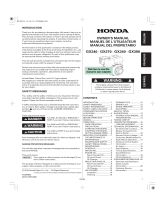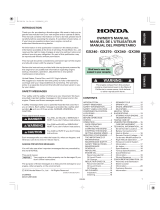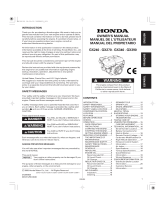Page is loading ...

HS928_1332_OM_31V41600HS928_1332_OM_31V41600
C2011 Honda Motor Co., Ltd. -All Rights Reserved
Owner,s Manual
SNOWBLOWER
HS928 HS1332
Printed in Japan
NAH HC
Hi
EM3
31V41600
00X31-V41-6000
2000.2011.06

Keep this owner’s manual handy, so you can refer to it any time. This
owner’s manual is considered a permanent part of the snowblower
and should remain with the snowblower if resold.
The information and specifications included in this publication were in
effect at the time of approval for printing. Honda Motor Co., Ltd.
reserves the right, however, to discontinue or change specifications or
design at any time without notice and without incurring any obligation
whatever.
The engine exhaust from this product
contains chemicals known to the State
of California to cause cancer, birth
defects or other reproductive harm.
11/05/30 13:05:59 31V41600_001

1
INTRODUCTION
Congratulations on your selection of a Honda snowblower. We are
certain you will be pleased with your purchase of one of the finest
snowblowers on the market.
We want to help you get the best results from your new snowblower
and to operate it safely. This manual contains the information on how
to do that; please read it carefully.
As you read this manual, you will find information preceded by a
symbol. That information is intended to help you avoid
damage to your snowblower, other property, or the environment.
We suggest you read the warranty policy to fully understand its
coverage and your responsibilities of ownership. The warranty policy
is a separate document that should have been given to you by your
dealer.
When your snowblower needs scheduled maintenance, keep in mind
that your Honda servicing dealer is specially trained in servicing
Honda snowblowers. Your Honda servicing dealer is dedicated to your
satisfaction and will be pleased to answer your questions and
concerns.
Best Wishes,
Honda Motor Co., Ltd.
11/05/30 13:06:06 31V41600_002

2
INTRODUCTION
A FEW WORDS ABOUT SAFETY
Safety Labels
Safety Messages
Safety Headings
Safety Section
Instructions
Your safety and the safety of others are very important. And using this
snowblower safely is an important responsibility.
To help you make informed decisions about safety, we have provided
operating procedures and other information on labels and in this
manual. This information alerts you to potential hazards that could
hurt you or others.
Of course, it is not practical or possible to warn you about all the
hazards associated with operating or maintaining a snowblower. You
must use your own good judgment.
You will find important safety information in a variety of forms,
including:
on the snowblower.
preceded by a safety alert symbol and one
of three signal words, DANGER, WARNING, or CAUTION.
These signal words mean:
such as
IMPORTANT SAFETY INFORMATION
.
such as
SNOWBLOWER SAFETY
.
how to use this snowblower correctly and safely.
This entire book is filled with important safety information please
read it carefully.
be or if
you don’t follow instructions.
be or if
you don’t follow instructions.
be if you don’t follow
instructions.
You WILL KILLED SERIOUSLY HURT
You CAN KILLED SERIOUSLY HURT
You CAN HURT
11/05/30 13:06:19 31V41600_003

3
CONTENTS
...........................................................................SNOWBLOWER SAFETY .5
..........................................................................CONTROLS & FEATURES .9
...............................................................................BEFORE OPERATION .18
..............................................................................................OPERATION .21
........................................................SERVICING YOUR SNOWBLOWER .34
..................................................IMPORTANT SAFETY INFORMATION .5
.................................................................SAFETY LABEL LOCATIONS .8
.............................................COMPONENT & CONTROL LOCATIONS .9
............................................................................................CONTROLS .11
................................................................................Fuel Valve Lever .11
....................................................................................Engine Switch .11
.........................................................................................Fuel Gauge .11
.......................................................................................Chute Crank .12
........................................................................................Starter Grip .12
....................................................................................Throttle Lever .12
.......................................................................................Choke Knob .13
..........................................................................................Shift Lever .13
................................................................Discharge Deflector Lever .14
..........................................................................................Foot Pedal .14
....................................Drive Clutch Lever and Auger Clutch Lever .15
............................................................Transmission Release Lever .16
.............................................................................................FEATURES .17
.........................................................................................Work Light .17
............................................................................Snow Clearing Bar .17
................................................ARE YOU READY TO GET STARTED? .18
.........................................IS YOUR SNOWBLOWER READY TO GO? .18
..........................Check the General Condition of the Snowblower .19
...............................................................................Check the Engine .19
.................................................................CHECK YOUR WORK AREA .20
.......................................................SNOWBLOWING PRECAUTIONS .21
......................................................................STARTING THE ENGINE .21
......................................................................STOPPING THE ENGINE .26
.................................................................................CLEARING SNOW .29
........................................................................SNOW-CLEARING TIPS .32
..............................................................REMOVING OBSTRUCTIONS .33
.............................................THE IMPORTANCE OF MAINTENANCE .34
......................................................................MAINTENANCE SAFETY .35
...............................................................................................TOOL KIT .37
................................................................MAINTENANCE SCHEDULE .38
...........................................................................................REFUELING .40
...............................................................FUEL RECOMMENDATIONS .41
11/05/30 13:06:23 31V41600_004

4
CONTENTS
SERVICING YOUR SNOWBLOWER (continued)
..................................................................................................STORAGE .54
......................................................................................TRANSPORTING .60
.......................................TAKING CARE OF UNEXPECTED PROBLEMS .63
....................................................................TECHNICAL INFORMATION .68
...................................................................CONSUMER INFORMATION .75
.............................QUICK REFERENCE INFORMATION .Inside back cover
..................................................................ENGINE OIL LEVEL CHECK .42
...........................................................................ENGINE OIL CHANGE .43
....................................................ENGINE OIL RECOMMENDATIONS .44
.............................................HYDROSTATIC TRANSMISSION FLUID .45
.........................................................................SPARK PLUG SERVICE .47
.........................................................................TRACK ADJUSTMENT .49
.................................................................................TIRE INSPECTION .50
..................................................AUGER AND BLOWER INSPECTION .50
.........................................LOCK BOLT REPLACEMENT PROCEDURE .51
...............................................................SKID SHOES AND SCRAPER .52
....................................................................STORAGE PREPARATION .54
.............................................................................................Cleaning .54
.....................................................................................................Fuel .55
..........................................................................................Engine Oil .58
....................................................................................................Tires .58
...................................................................STORAGE PRECAUTIONS .59
..................................................................REMOVE FROM STORAGE .59
................................................................................BEFORE LOADING .60
...............................................................................................LOADING .61
.............................................................................ENGINE PROBLEMS .63
........................................................................Engine Will Not Start .63
..........................................................................Engine Lacks Power .64
..............................................................................DRIVER PROBLEMS .65
...........................................................Snowblower Does Not Move .65
...............................................................SNOWBLOWER PROBLEMS .66
.......................................................Snowblower Does Not Operate .66
..................................................................Serial Number Locations .68
....................Carburetor Modification for High Altitude Operation .69
............................................Emission Control System Information .70
.............................................................................................Air Index .72
....................................................................................Specifications .73
.........................................................................Honda PUBLICATIONS .75
.........................................................Customer Service Information .76
11/05/30 13:06:28 31V41600_005

5
IMPORTANT SAFETY INFORMATION
Avoid Rotating Impeller and Auger
Clear Operation Area
SNOWBLOWER SAFETY
Honda snowblowers are designed to clear snow from driveways and
walkways. Other uses can result in injury to the operator or damage to
the snowblower and other property.
Most injuries or property damage with snowblowers can be prevented
if you follow all instructions in this manual and on the snowblower.
The most common hazards, are discussed below, along with the best
way to protect yourself and others.
Hand contact with the rotating impeller inside the discharge chute is
the most common cause of injury associated with snowblowers. The
snowblower auger can also cause serious injury. Keep away from the
impeller and auger whenever the engine is running. If you need to
work around the snowblower to clear snow for any reason, always
shut off the engine. If the snow discharge chute becomes clogged,
stop the engine and disconnect the spark plug cap. Use the snow
clearing bar or a wooden stick to remove the obstructions. Never put
your hand into the snow discharge chute while the engine is running;
serious personal injury could result.
The snowblower can throw rocks and other objects with enough force
to cause serious injury. Before operating the snowblower, carefully
inspect the area and remove any visible stones, sticks, bones, nails,
pieces of wire, and other loose objects. Never use the snowblower to
clear snow from a gravel road or driveway, as rocks may be picked up
and ejected. They may cause injury to bystanders.
11/05/30 13:06:35 31V41600_006

6
SNOWBLOWER SAFETY
Keep Shields in Place
Refuel with Care
Operation on Slopes
Turn Engine OFF When Not Operating the Snowblower
Guards and shields are designed to protect you from being hit by
thrown objects and to keep you from touching hot engine parts and
moving components. For your safety and the safety of others, keep all
shields in place when the engine is running.
Adjust the snow discharge chute to avoid hitting the operator,
bystanders, windows, and other objects with ejected snow. Stay clear
of the snow discharge chute while the engine is running.
Children and pets must be kept away from the area of operation to
avoid injury from flying debris and contact with the snowblower.
Gasoline is extremely flammable, and gasoline vapor can explode.
Allow the engine to cool if the snowblower has been in operation.
Refuel only outdoors in a well-ventilated area with the engine OFF. Do
not overfill the fuel tank. Never smoke near gasoline, and keep other
flames and sparks away. Always store gasoline in an approved
container. Make sure that any spilled fuel has been wiped up before
starting the engine.
To avoid overturning, be careful when changing the direction of the
snowblower while operating it on a slope. Do not use the snowblower
to remove snow from roofs. The snowblower may overturn on steep
slopes if left unattended causing injury to the operator or bystanders.
If you need to leave the snowblower for any reason, even just to
inspect the area ahead, always turn the engine off.
11/05/30 13:06:46 31V41600_007

7
SNOWBLOWER SAFETY
Operating Conditions
Operator Responsibility
Operating Near Roads
Exercise caution on slippery surfaces to avoid falling, especially when
operating in reverse.
Wear safety glasses or eye shields during operation to protect eyes
from thrown objects.
While operating the snowblower, hold the handle firmly, and walk,
don’t run. Wear suitable winter boots that resist slipping.
Never permit anyone to operate the snowblower without proper
instruction. Do not let children operate the snowblower. If people or
pets suddenly appear in front of the snowblower while it is in
operation, immediately release the auger and drive clutch levers to
stop the snowblower and avoid possible injury from rotating auger
blades.
Know how to stop the snowblower quickly in case of emergency.
Understand the use of all snowblower controls.
Always watch for vehicle traffic when operating the snowblower near
roads and driveways.
Do not use the snowblower when visibility is poor. Under conditions
of poor visibility, there is a greater risk of striking an obstacle or
causing injury. Adjust the snow discharge chute to avoid hitting
passing bystanders or vehicles.
Stay clear of the snow discharge chute while the engine is running and
be aware that loose clothing can get drawn into the moving parts.
11/05/30 13:06:55 31V41600_008

8
SNOWBLOWER SAFETY
SAFETY LABEL LOCATIONS
If a label comes off or becomes hard to read, contact your Honda
snowblower dealer for a replacement.
These labels warn you of potential hazards that can cause serious
injury. Read them carefully.
11/05/30 13:07:24 31V41600_009

9
CONTROLS & FEATURES
COMPONENT & CONTROL LOCATIONS
Track type
AUGER CLUTCH LEVER
TRANSMISSION
FLUID RESERVOIR
ENGINE SWITCH
FUEL VALVE
CHUTE CRANK
STARTER GRIP
CHOKE KNOB
FOOT PEDAL
DRIVE CLUTCH
LEVER
FUEL TANK CAP
AUGER
SKID SHOE
DISCHARGE DEFLECTOR
SNOW DISCHARGE
CHUTE
WORK LIGHT
MUFFLER
TRACK
SHIFT LEVER
AC STARTER BUTTON
(TAS type)
SNOW CLEARING BAR
ENGINE OIL
FILLER CAP
DISCHARGE DEFLECTOR LEVER
THROTTLE LEVER
ENGINE SERIAL
NUMBER
TRANSMISSION
RELEASE LEVER
FRAME SERIAL
NUMBER
Use the two illustrations on these pages to locate and identify the
most frequently used controls.
11/05/30 13:07:33 31V41600_010

10
CONTROLS & FEATURES
Wheel type
AUGER CLUTCH LEVER
TRANSMISSION
FLUID RESERVOIR
ENGINE SWITCH
FUEL VALVE
THROTTLE LEVER
DISCHARGE DEFLECTOR
STARTER GRIP
CHOKE KNOB
ENGINE OIL
FILLER CAP
DRIVE CLUTCH
LEVER
SHIFT LEVER
WORK LIGHT
SNOW DISCHARGE
CHUTE
FUEL TANK CAP
AUGER
MUFFLER
DISCHARGE DEFLECTOR LEVER
WHEEL
CHUTE CRANK
FRAME SERIAL NUMBER
SNOW CLEARING BAR
AC STARTER BUTTON
(WAS type)
TRANSMISSION RELEASE LEVER SKID SHOE
ENGINE SERIAL NUMBER
11/05/30 13:07:41 31V41600_011

11
CONTROLS & FEATURES
CONTROLS
Engine Switch
Fuel Valve Lever
Fuel Gauge
ENGINE SWITCH
OOFFFF
ON
FUEL GAUGE
OONN
FUEL VALVE LEVER
OFF
FULL
EMPTY
The fuel valve opens and closes
the fuel line leading from the fuel
tank to the carburetor. Make sure
that the fuel valve is positioned
exactly at either the ON or OFF
position. When the snowblower is
not in use, always leave the fuel
valve in the OFF position to
reduce the possibility of fuel
leakage.
ON Running position, and for
starting with the recoil starter.
OFF Stops the engine.
The engine switch controls the
ignition system. The key can only
be inserted and removed when
turned to OFF.
The fuel gauge indicates the
amount of fuel in the tank. When
the fuel gauge needle enters the
EMPTY position, refill the tank as
soon as possible.
11/05/30 13:07:53 31V41600_012

12
CONTROLS & FEATURES
Chute Crank
Starter Grip
Throttle Lever
SLOW
FFAASSTT
STARTER GRIP
CHUTE CRANK
To throw snow to the right
To throw snow to the left
THROTTLE LEVER
Use the chute crank to turn the snow discharge chute right or left.
See page for starting
procedures.
Pull this grip to start the engine.
The throttle lever controls engine
speed from SLOW to FAST, it will
stay in any designated position.
24
11/05/30 13:08:04 31V41600_013

13
CONTROLS & FEATURES
Choke Knob
Shift Lever
CHOKE KNOB
CLOSED
OPEN
R (Reverse)
N (Neutral)
SHIFT LEVER
F (Forward)
The choke knob opens and closes the choke valve in the carburetor.
The CLOSED position enriches the fuel mixture for starting a cold
engine.
The OPEN position provides the correct fuel mixture for operation
after starting, and for restarting a warm engine.
The shift lever selects F (FORWARD), N (NEUTRAL), or R (REVERSE).
The shift lever also controls the transmission drive ratio; moving the
lever farther from NEUTRAL increases drive speed. While clearing
snow, use the shift lever to control drive speed, so you can leave the
throttle lever in the FAST position for best snow-clearing performance.
11/05/30 13:08:13 31V41600_014

14
CONTROLS & FEATURES
Discharge Deflector Lever
Foot Pedal (track type only)
HIGH AND FAR
LOW AND NEAR
HIGH AND FAR
LOW AND NEAR
FOOT PEDAL
HIGH
MIDDLE
LOW
DISCHARGE DEFLECTOR
DISCHARGE DEFLECTOR LEVER
The discharge deflector lever controls the snow discharge angle.
HIGH Deep snow or for transporting the snowblower.
MIDDLE Normal use.
LOW Smooth, ice-covered surfaces only.
Use the pedal for adjusting the height and angle of the machine in
relation to the tracks.
Hold the handles and step on the pedal.
Raise or lower the machine to the desired position and release the
pedal.
11/05/30 13:08:24 31V41600_015

15
CONTROLS & FEATURES
Drive Clutch Lever and Auger Clutch Lever
DRIVE CLUTCH LEVER
Squeeze to engage the
drive transmission.
The auger clutch lever
remains locked down as
long as one hand continues
to squeeze the drive clutch lever.
DRIVE CLUTCH LEVER
Both levers squeezed
AUGER CLUTCH LEVER
Squeeze to engage the
snow blowing mechanism.
LLOOCCKKEEDD
Use these controls to engage the snow blowing mechanism and/or the
drive mechanism.
When both levers are squeezed, the drive clutch lever locks the auger
clutch lever down. Releasing the drive clutch lever then unlocks and
releases the auger clutch lever.
11/05/30 13:08:31 31V41600_016

16
CONTROLS & FEATURES
Transmission Release Lever
TRANSMISSION RELEASE LEVER
RREELLEEAASSEEDDEENNGGAAGGEEDD
Operating the transmission release lever while the engine is running
can damage the transmission.
Stop the engine.
Set the shift lever in the ‘‘N’’ (Neutral) position.
Set the lever in the ENGAGED or RELEASED position.
The transmission release lever has two positions, RELEASED and
ENGAGED. Set the lever in the ENGAGED position for self-propelled
operation. Set it in the RELEASED position when pushing the
snowblower with the engine stopped.
Pushing or towing the snowblower with the transmission release
control in the engaged position will damage the hydrostatic
transmission.
1.
2.
3.
11/05/30 13:08:38 31V41600_017

17
CONTROLS & FEATURES
Work Light
FEATURES
Snow Clearing Bar
WORK LIGHT
HOLDERS
SNOW CLEARING BAR
DDOOWWNN
UUPP
The light comes ON while the
engine is running, and it goes OFF
when the engine stops. The light
does not come ON when the
engine switch is turned ON unless
the engine is started. The light can
be adjusted up or down.
If the snow discharge chute or
snow blowing mechanism
becomes restricted, stop the
engine, and make sure all rotating
parts have come to a complete
stop. Remove the spark plug cap
from the spark plug.
Use the snow clearing bar to
remove the obstruction.
After clearing the obstruction,
wipe the bar clean, and store it in
the holders. Replace the spark
plug cap.
11/05/30 13:08:48 31V41600_018

18
BEFORE OPERATION
ARE YOU READY TO GET STARTED?
Knowledge
IS YOUR SNOWBLOWER READY TO GO?
Your safety is your responsibility. A little time spent in preparation will
significantly reduce your risk of injury.
Read and understand this manual. Know what the controls do and
how to operate them.
Familiarize yourself with the snowblower and its operation before you
begin using it. Know how to quickly shut off the snowblower in case of
an emergency.
For your safety, and to maximize the service life of your equipment, it
is very important to take a few moments before you operate the
snowblower to check its condition. Be sure to take care of any problem
you find, or have your servicing dealer correct it, before you operate
the snowblower.
Improperly maintaining this
snowblower, or failing to correct a
problem before operation, could
cause a malfunction in which you
could be seriously injured.
Always perform a pre-operation
inspection before each operation,
and correct any problem.
Before beginning your pre-operation checks, be sure the snowblower
is on a level surface and the engine switch is in the OFF position.
11/05/30 13:08:58 31V41600_019
/








